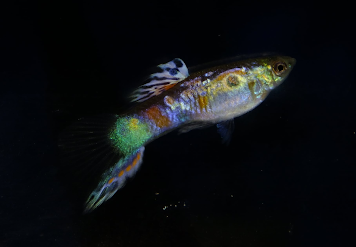A REKINDLED INTEREST IN SPEARTAIL GUPPIES
Why have Speartails dissappeared from the tanks of breeders in North America? Think it's about time we make a change in that trend...
%20Speartail.jpg) |
| Multi-Colored Speartail, courtesy of Whitney, L 1952 - All About Guppies |
© Alan S. Bias
For the past two years give or take I've started back working with Speartails. Something I have not done since a teenager, and that was quite some time ago. Over 45 years ago to be exact. Foundation stocks for my current Speartail breedings were obtained from my good friend and fellow breeders Gary Lee of Taipei, Taiwan and Henrik Schneider of Großaltenstädten, Hessen, Germany.
 |
| Halfblack Snakeskin Speartail, photo courtesy Gary Lee |
 |
| Schimmelpennig Platinum Speartail, photo courtesy Henrik Schneider |
Henrik has also produced some wonderful results within his Speartail breeding program. He has concentrated primarily on Schimmelpennig Platinum (Y-Sc) in Blond (b) & Purple Body (Pb) phenotypes. Also entering his best fish in IKGH shows and providing stocks to breeders in Europe, and now Asia and North America. His breedings and show results can be found and followed at Hessen Guppys.
At one time Speartails, and other small tail phenotypes, were quite common in North America and around the world. Reasons for loss of interest and thier demise can only be based on speculation. In part the rise of Broadtail phenotypes, to include delta and viel, in the 1950-70s played a played a roll in declining interest.
%20crop%20.jpg) |
| Photo courtesy Madsen 1974 - Aquarium Fishes in Color |
Such extensions preclude use of many of the best Speartail males as potential sires without surgical alteration or at best use during a very brief period of time just after the onset of sexual maturity. Well before mature finnage and other attributes can be thoroughly evaluated.
Speartail is also intrinsic with Opaque (Op) genotype. Another autosomal incompletely dominant gene which alters angles of crystalline plateletes which reside under the violet-blue iridophore structureal color layer. Producing "dull and muted" colors, i.e. translucent scale phenotypes. In homozygous fashion this color inhibition can be quite dramatic, again resulting in a high cull rate.
Lacking a class to exhibit within the International Fancy Guppy Association (IFGA), Speartails are now rarely seen, if not absent, in the tanks of American and Canadian breeders. Though, they have persisted in the hands of Europian breeders and within the confines of International Kuratorium Guppy High-breeding (IKGH) shows.
In Asia interest in breeding Speartails has seen a steady increase over the last several years. Though, much of this interest has been commercially driven and not often in the hands of breeders dedicated to producing show quality stocks that adhere to established IKGH standards. While resulting in many novel Speartail phenotypes, quality is often lacking and many fail to take hold and persist in breeder tanks.
On occasion, "spear-like" phenotypes are seen among breeder results with wild-type Guppies. Most of these do not stem from defined Speartail breedings. Rather, they derive from reciprocal Peocilia reticulata x P. r. wingei breedings. While such individuals can be refined through selection and backcross into true Speartails, most are used in a fashion which continues to produce haphazard results.
As with all complex phenotypes, selection for Speartails cannot be maintained indefinitaely without periodic outcross from compatible stocks existing within a breeders population or from infusion of unrelated stocks sourced from other breeders. Attempting to linebred long-term or indiscriminately will result in severely reduced fecundity across all aspects, both visible and unseen.
Speartails, like many unique finnage modifications, require a rigid selection criteria requiring high rate of culling to produce a rather small percentage of desired result. Upon outcross, initial F1 and F2 offspring will produce a varied result in dorsal and caudal expressions. Most of which will be culled from a breeding program. A select few may be used to recombine desired genotype.
 |
| F1 Lowersword x Spear outcross |
At the moment I'm working with two specific phenotypes and outcrossings with my various Lowersword phenotypes, as seen in the following photos. Will see where this journey takes me and if they will continue to hold my long-term interests? Only time will tell...
 |
| Blond Schim Plat Purple Body Spear |
 | ||||
Blond Schim Plat Purple Body Spear
|
 |
| Red Snakeskin Saddleback Spear |
 |
| Red Snakeskin Saddleback Spear |
 |
| Red Snakeskin Saddleback Spear |







